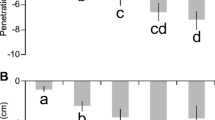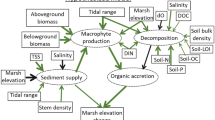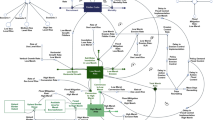Abstract
The loss of coastal marshes is a topic of great concern, because these habitats provide tangible ecosystem services and are at risk from sea-level rise and human activities. In recent years, a significant effort has gone into understanding and modeling the relationships between the biological and physical factors that contribute to marsh stability. Simulation-based process models suggest that marsh stability is the product of a complex feedback between sediment supply, flooding regime and vegetation response, resulting in elevation gains sufficient to match the combination of relative sea-level rise and losses from erosion. However, there have been few direct, empirical tests of these models, because long-term datasets that have captured sufficient numbers of marsh loss events in the context of a rigorous monitoring program are rare. We use a multi-year dataset collected by the Coastwide Reference Monitoring System that includes transitions of monitored vegetation plots to open water to build and test a predictive model of near-term marsh vulnerability. We found that despite the conclusions of previous process models, elevation change had no ability to predict the transition of vegetated marsh to open water. However, we found that the processes that drive elevation change were significant predictors of transitions. Specifically, vegetation cover in prior year, land area in the surrounding 1 km2 (an estimate of marsh fragmentation) and the interaction of tidal amplitude and position in tidal frame were all significant factors predicting marsh loss. This suggests that (1) elevation change is likely better a predictor of marsh loss at timescales longer than we consider in this study and (2) the significant predictive factors affect marsh vulnerability through pathways other than elevation change, such as resistance to erosion. In addition, we found that, while sensitivity of marsh vulnerability to the predictive factors varied spatially across coastal Louisiana, vegetation cover in prior year was the best single predictor of subsequent loss in most sites followed by changes in percent land and tidal amplitude. The model’s predicted land loss rates correlated well with land loss rates derived from satellite data, although agreement was spatially variable. These results indicate (1) monitoring the loss of small-scale vegetation plots can inform patterns of land loss at larger scales, (2) the drivers of land loss vary spatially across coastal Louisiana, and (3) relatively simple models have potential as highly informative tools for bioassessment, directing future research and management planning.






Similar content being viewed by others
References
Bass A, Turner RE. 1997. Relationships between salt marsh loss and dredged canals in three south Louisiana estuaries. J Coas Res 13:895–903.
Baustian JJ, Mendelssohn IA, Hester MW. 2012. Vegetation’s importance in regulating surface elevation in a coastal salt marsh facing elevated rates of sea level rise. Global Change Biol 18:3377–82.
Cahoon DR. 2015. Estimating relative sea-level rise and submergence potential at a coastal wetland. Estuar Coasts 38(1077):1084.
Cahoon DR, Lynch JC, Perez BC, Segura B, Holland RD, Stelly C, Stephenson G, Hensel P. 2002. High precision measurement of wetland sediment elevation—II. The rod surface elevation table. J Sedim Res 72:734–9.
Cahoon DR, Hensel P, Rybczyk J, McKee KL, Proffitt CE, Perez BC. 2003. Mass tree mortality leads to mangrove peat collapse at Bay Islands, Honduras after Hurricane Mitch. J Ecol 91:1093–105.
Cahoon DR, Hensel PE, Spencer T, Reed D, McKee KL, Saintilan N. 2006. Coastal wetland vulnerability to relative sea-level rise: wetland elevation trends and process controls. In: Verhoeven JTA, Beltman B, Bobbink R, Whigham DF, Eds. Wetland and natural resource management. Berlin: Springer. p 271–92.
Cinner JE et al. 2017. Bright spots among the world’s coral reefs. Nature 535:415–19.
Coastal Wetlands Planning, Protection and Restoration Act (CWPPRA). 1993. Louisiana coastal wetlands restoration plan. CWPPRA Program Reports.
Couvillion BR, Barras JA, Steyer GD, Sleavin W, Fischer M, Beck H, Trahan N, Griffin B, Heckman D. 2011. Land area change in coastal Louisiana from 1932 to 2010. U.S. Geological Survey Scientific Investigations Map 3164, Scale 1:265,000, pamphlet.
Couvillion BR, Fischer MR, Beck HJ, Sleavin WJ. 2016. Spatial configuration trends in coastal Louisiana from 1985 to 2010. Wetlands 36:347–59.
Cretini KF, Visser JM, Krauss KW, Steyer GD. 2011. CRMS vegetation analytical team framework—methods for collection, development, and use of vegetation response variables. U.S. Geological Survey Open-File Report 2011–1097.
Day JW, Christian RR, Boesch DM, Yanez-Arancibia A, Morris J, Tilley RR, Naylor L, Schaffner L, Stevenson C. 2008. Consequences of climate change on the ecogeomorphology of coastal wetlands. Estuar Coasts 31:477–91.
DeLaune RD, Nyman JA, Patrick WH Jr. 1994. Peat collapse, ponding and wetland Loss in a rapidly submerging coastal marsh. J Coast Res 10:1021–30.
Ensign SH, Hupp CR, Noe GB, Krauss KW, Stagg CL. 2014. Sediment accretion in tidal freshwater forests and oligohaline marshes of the Waccamaw and Savannah Rivers, USA. Estuar Coasts 37:1107–19.
Fagherazzi S, Marani M, Blum LK. 2004. Introduction: the coupled evolution of geomorphological and ecosystem structures in salt marshes. In: Fagherazzi S, Marani M, Blum LK, Eds. The ecogeomorphology of tidal marshes, coastal Estuarine Stud. Washington, DC: AGU. p 1–5.
Feagin RA, Lozada-Bernard SM, Ravens TM, Möller I, Yeager KM, Baird AH. 2009. Does vegetation prevent wave erosion of salt marsh edges? PNAS 106:10109–13.
Folse TM, Sharp LA, West JL, Hymel MK, Troutman JP, McGinnis TE, Weifenbach D, Boshart WM, Rodrigue LB, Wood WB, Miller CM. 2014. A standard operating procedures manual for the coastwide reference monitoring system-wetlands: methods for site establishment, data collection, and quality assurance/quality control. Baton Rouge, LA: Louisiana Coastal Protection and Restoration Authority. p 228.
Friedrichs CT, Perry JE. 2001. Salt marsh morphodynamics: a synthesis. J Coast Res 27:7–37.
Gedan KB, Kirwan ML, Wolanski E, Barbier EB, Silliman BR. 2011. The present and future role of coastal wetland vegetation in protecting shorelines: answering recent challenges to the paradigm. Clim Change 106:7–29.
Gelman G, Hill J. 2009. Data analysis using regression and multivariate/hierarchical models. New York, NY: Cambridge University Press.
Glick P, Clough J, Polaczyk A, Couvillion B, Nunley B. 2013. Potential effects of sea-level rise on coastal wetland in Southeastern Louisiana. J Coast Res 63:211–33.
Harrison EZ, Bloom AL. 1977. Sedimentation rates on tidal salt marshes in Connecticut. J Sediment Petrol 47:1484–90.
Hartig EK, Gornitz V, Kolker A, Mushacke F, Fallon D. 2002. Anthropogenic and climate-change impacts on salt marshes of Jamaica Bay, New York City. Wetlands 22:71–89.
Honaker J, King G, Blackwell M. 2011. Amelia II: a program for missing data. J Stat Softw 45:1–47.
Hosmer DW Jr, Lemeshow S. 2000. Applied logistic regression. New York: Wiley.
Kennish M. 2001. Coastal salt marsh systems in the U.S.: a review of anthropogenic impacts. J Coast Res 17:731–48.
Kirwan ML, Guntenspergen GR. 2010. Influence of tidal range on the stability of coastal marshland. J Geophys Res 115:F02009.
Kirwan ML, Guntenspergen GR. 2012. Feedbacks between inundation, root production, and shoot growth in a rapidly submerging brackish marsh. J Ecol 100:764–70.
Kirwan ML, Murray AB. 2008. Tidal marshes as disequilibrium landscapes? Lags between morphology and Holocene sea level change. Geophys Res Lett 35:L24401.
Kirwan ML, Walters DC, Reay WG, Carr JA. 2016. Sea level driven marsh expansion in a coupled model of marsh erosion and migration. Geophys Res Lett 43:4366–74.
Leonard LA, Luther ME. 1995. Flow hydrodynamics in tidal marsh canopies. Limnol Oceanogr 40:1474–84.
Marani M, D’Alpaos A, Lanzoni S, Carniello L, Rinaldo A. 2007. Biologically-controlled multiple equilibria of tidal landforms and the fate of the Venice lagoon. Geophys Res Lett 34:L11402.
Marani M, D’Alpaos A, Lanzoni S, Santalucia M. 2011. Understanding and predicting wave erosion of marsh edges. Geophys Res Lett 38:L21401.
Mariotti G, Carr J. 2014. Dual role of salt marsh retreat: long-term loss and short-term resilience. Water Resour Res 50:2963–74.
Mariotti G, Fagherazzi S. 2010. A numerical model for the coupled long-term evolution of salt marshes and tidal flats. J Geophys Res 115:F01004.
McKee KL. 2011. Biophysical controls on accretion and elevation change in Caribbean mangrove ecosystems. Estuar Coast Shelf Sci 91:475–83.
Morris JT, Sundareshwar PV, Nietch CT, Kjerfve B, Cahoon DR. 2002. Responses of coastal wetlands to rising sea level. Ecology 83:2869–77.
Mudd SM, Howell SM, Morris JT. 2009. Impact of dynamic feedbacks between sedimentation, sea-level rise, and biomass production on near surface marsh stratigraphy and carbon accumulation. Estuar Coast Shelf Sci 82:377–89.
Nicholls RJ, Hoozemans FMJ, Marchand M. 1999. Increasing flood risk and wetland losses due to global sea-level rise: regional and global analyses. Global Environ Change 9:S69–87.
Nyman JA, Delaune RD, Patrick WH Jr. 1990. Wetland soil formation in the rapidly subsiding Mississippi River Deltaic Plain: Mineral and organic matter relationships. Estuar Coast Shelf Sci 31:57–69.
Nyman JA, Walters RJ, Delaune RD, Patrick WH Jr. 2006. Marsh vertical accretion via vegetative growth. Estuar Coast Shelf Sci 69:370–80.
R Core Team. 2015. R: a language and environment for statistical computing. Vienna: R Foundation for Statistical Computing.
Rosen PS. 1977. Increasing shoreline erosion rates with decreasing tidal range in the Virginia Chesapeake Bay. Chesap Sci 18:383–6.
Shinkle KD, Dokka RK. 2007. Rates of vertical displacement at benchmarks in the Lower Mississippi Valley and the Northern Gulf Coast. Silver Spring: U.S. Department of Commerce, National Oceanic and Atmospheric Administration. p 147p.
Snedden GA, Swenson EM. 2012. Hydrologic index development and application to selected coastwide reference monitoring system sites and coastal wetlands planning, protection and restoration act projects. U.S. Geological Survey Open-File Report 2012–1122.
Steyer GD, Sasser CE, Visser JM, Swenson EM, Nyman JA, Raynie RC. 2003. A proposed coast-wide reference monitoring system for evaluating wetland restoration trajectories in Louisiana. Environ Monit Assess 81:107–17.
Temmerman S, Bouma TJ, Govers G, Wang ZB, De Vries MB, Herman PMJ. 2005. Impact of vegetation on flow routing and sedimentation patterns: Three-dimensional modeling for a tidal marsh. J Geophys Res 110:F04019.
Teal JM. 1962. Energy flow in the salt marsh ecosystem of Georgia. Ecology 43:614–24.
Turner RE, Swenson EM, Milan CS, Lee JM, Oswald TA. 2004. Below-ground biomass in healthy and impaired salt marshes. Ecol Res 19:29–35.
van de Koppel J, van der Wal D, Bakker JP, Herman PJM. 2005. Self-organization and vegetation collapse in salt-marsh ecosystems. Am Nat 165:E1–12.
Visser JM, Sasser CE. 1998. 1997 Coastal vegetation analysis. Baton Rouge, LA: Louisiana State University, Coastal Ecology Institute.
Acknowledgements
This work was supported by the CRMS Program, which is administered by CPRA and USGS and is funded through Coastal Wetland Planning Protection and Restoration Area, the State of Louisiana, with federal resource agencies including USFWS, NMFS, NRCS, EPA and the USACOE. Any use of trade, firm or product names is for descriptive purposes only and does not imply endorsement by the U.S. Government.
Funding
This work was supported by the CRMS Program, which is funded through the Coastal Wetlands Planning, Protection, and Restoration Act and the State of Louisiana. A task force of federal agencies, representing USACOE, USFWS, NOAA, NRCS and EPA, governs CWPPRA and provides oversight to CPRA and USGS for the implementation of CRMS.
Author information
Authors and Affiliations
Corresponding author
Ethics declarations
Conflict of interest
The authors declare that they have no conflict of interest.
Electronic supplementary material
Below is the link to the electronic supplementary material.
Rights and permissions
About this article
Cite this article
Schoolmaster, D.R., Stagg, C.L., Sharp, L.A. et al. Vegetation Cover, Tidal Amplitude and Land Area Predict Short-Term Marsh Vulnerability in Coastal Louisiana. Ecosystems 21, 1335–1347 (2018). https://doi.org/10.1007/s10021-018-0223-7
Received:
Accepted:
Published:
Issue Date:
DOI: https://doi.org/10.1007/s10021-018-0223-7




